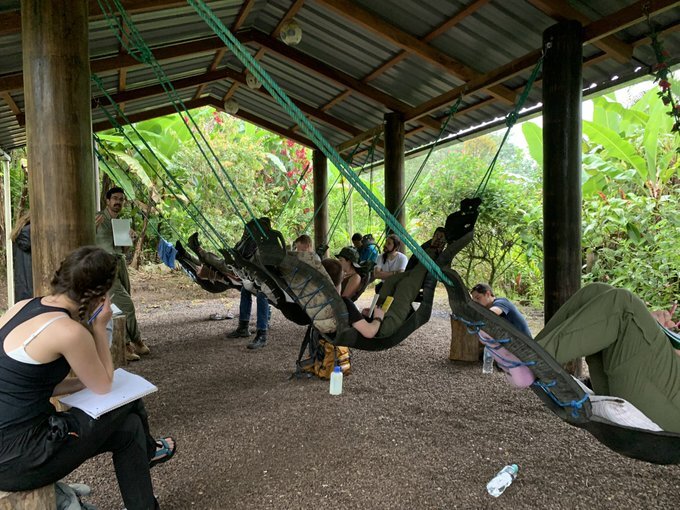Study abroad recap by Dr. Verble
Posted by Peter Ehrhard

The travelers are staying in a remote part of Ecuador. Photo from Dr. Robin Verble’s Twitter @r_verble.
From Dr. Robin Verble, associate professor of biological sciences:
Ecuador is home to breathtaking landscapes and some of the most biodiverse environments on Earth. Snowcapped volcanoes climb to dizzying heights above ancient cities and animals such as pink river dolphins, wire-tailed manakins, giant river otters, tapirs, and pygmy marmosets exist in dense jungles. Over the past year, I have worked with Dr. Gonzalo Rivas-Torres, the director of Tiputini Biodiversity Station to build connections between our Ozark Research Field Station and their Amazonian Forest field station.
This summer, as part of that endeavor, Theo Sumnicht, assistant teaching professor, and I led a 17-day study abroad adventure course to Ecuador with 10 Missouri S&T students and 4 Mizzou students. The students were enrolled in an advanced biodiversity course and an environmental conservation course. Over the duration of the courses, they had the opportunity to engage up-close with environmental issues and see the types of wildlife and diversity that most environmental scientists and biologists only dream about.
We started our trip in the cloud forests of Mindo. These forests occur at about 4,000 feet elevation on the western slopes of the Andes. Here, we visited a waterfall sanctuary, took some early morning birdwatching hikes (and saw species such as motmot, quetzal, mountain toucan, and trogon), and visited a sustainable chocolate-making facility.
The next day we headed to Cotopaxi Volcano, where we hiked to 16,000 feet in the snow. This hike was a challenge, but the views were stunning, and we were rewarded with candy bars at the warming station, and everyone ended the day feeling really proud of themselves!
The second half of the trip was spent in Amazonia. The rainforest has a special place in my heart and sharing it with students is one of the greatest joys of teaching. We started with a visit with a local Kichwa family.
The next day, we departed for Tiputini Biodiversity Station. Tiputini is a remote field station located in the heart of Yasuni Biosphere Reserve. To get there, you take a two-hour trip by motorized canoe. Then you take a two-hour bus ride. Then you take another two-hour trip by motorized canoe. Once you arrive, there is no hot water, no internet, no air conditioning, and electricity is only available for two hours in the morning and two hours in the evening.
Here’s a few things students said in their reflections about the trip:
- “The disconnection from the outside world and reduced resources we worked with in Tiputini, which I expected to be the most unpleasant part of the trip, turned out to be one of the aspects I appreciated the most,” said Carson Dudley.
- “The little community we have created here with the laughing crew, the joking guides, and the focused researchers is strange and exciting when the only research environment I know is sitting in companionable silence at a lab bench,” said Alex Daniels. “I’m glad I came to see how other people in the world live and how research can look different for everyone, and how to challenge my preconceived notions.”
- “I went into this study abroad experience excited to get out bushwhacking and be a true international researcher for a few days,” said Dylan Johnson. “‘Kid me’ would be proud and get to cross ‘visit the Amazon rainforest’ from his bucket list. This trip was so much more than just a tick on a box though. It was a transformative experience. It exposed me to an entirely new world, got me back into a mindset of working with others, and renewed my vigor to see what the world has to offer.”
- “Witnessing the beauty and fragility of ecosystems firsthand incited my determination to contribute to their preservation,” said Patrick Lynch. “I am inspired to advocate for sustainable practices, raise awareness about environmental issues, and work towards a more sustainable future. Through my experiences with the researchers at the station, I also now am considering a future in research. This study abroad experience has been transformative, both academically and personally. It has provided me with a newfound appreciation for the world’s diversity and the interconnectedness of our global community. It has fostered empathy, cultural understanding, and a deep respect for our environment. As I return home, I’m bringing with me not just souvenirs, but also lifelong memories, friendships, and a renewed sense of purpose. The experiences and lessons learned in Ecuador will forever be a part of who I am. I am grateful for this incredible opportunity to grow, learn, and contribute to a better world.”
I couldn’t have said it better than they did. Study abroad teaches students so much more than just the course content. They learn about themselves, the world, a new culture, and how to navigate challenges. The same is true for us as professors – each trip and each class brings new challenges and new adventures, and we, too, continue to learn and grow, as a result. I’m looking forward to the next study abroad adventure but am already nostalgic for this one.
Saludos!
Leave a Reply